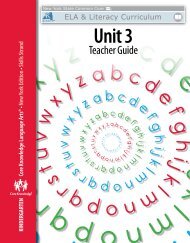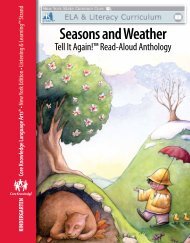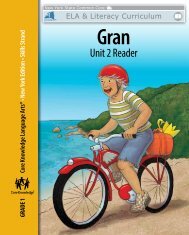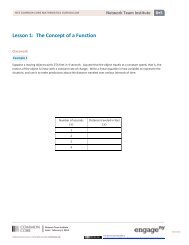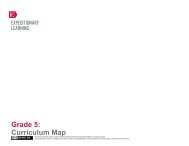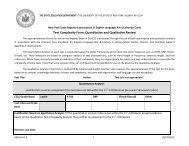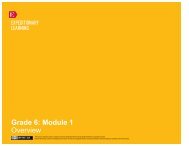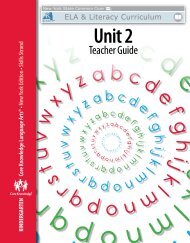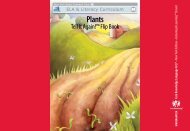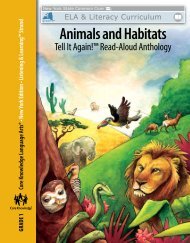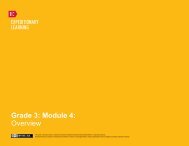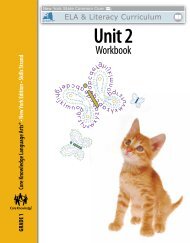Tell It Again! Read-Aloud Anthology - EngageNY
Tell It Again! Read-Aloud Anthology - EngageNY
Tell It Again! Read-Aloud Anthology - EngageNY
You also want an ePaper? Increase the reach of your titles
YUMPU automatically turns print PDFs into web optimized ePapers that Google loves.
Presenting the <strong>Read</strong>-<strong>Aloud</strong><br />
15 minutes<br />
Working on the Transcontinental Railroad<br />
Show image 8A-2: Michael holding a photo of his ancestor<br />
1 What word do you hear in the word<br />
continental? That’s right, continent.<br />
2 Ling Wei is Michael’s ancestor<br />
because he lived many, many years<br />
before Michael was born and is<br />
related to his family.<br />
My name is Michael, and this is a photo of my great-greatgreat-great-great-grandfather<br />
Ling Wei. He helped to build the<br />
transcontinental railroad. That’s a pretty long word, but it’s easy<br />
to understand if you split it into two parts. The first part of the<br />
word is trans–, which means across, and the second part is the<br />
word continental. 1 So, my ancestor Ling Wei helped build a part<br />
of the railroad that goes across the continental United States, or<br />
from the East Coast to the West Coast. 2<br />
Show image 8A-3: Map of existing and proposed railroad lines<br />
3 [Point out the red lines on the map<br />
that show railroad lines in 1863.]<br />
4 If something is convenient, it is<br />
suitable for your needs, or causes<br />
the least difficulty.<br />
Ling Wei began working on the railroad in 1863. By that time,<br />
there were many railroads in the United States. But they mostly<br />
went from the Northeast to the Southeast or from eastern cities<br />
like Baltimore to cities in the Midwest like Omaha, Nebraska. 3 <strong>It</strong><br />
was cheaper, more comfortable, and more convenient for people<br />
to travel by rail than to travel by canal or wagon. <strong>It</strong> was faster,<br />
too. 4 Before the transcontinental railroad, people could only travel<br />
to the West by wagon or horse, or by boat on a river or canal, and<br />
the going was slow.<br />
Show image 8A-4: Many workers laying tracks<br />
5 What was the “iron horse”?<br />
6 or went from the eastern side of<br />
the United States to the western<br />
side. [Point to the following areas<br />
on a U.S. map as you read.]<br />
7 What else have you learned<br />
about that ended in Sacramento,<br />
California?<br />
Because the “iron horse” 5 was faster, cheaper, more<br />
comfortable, and more convenient, many people thought it would<br />
be a great idea to have a railroad track that spanned the entire<br />
United States. 6 My great-great-great-great-great-grandfather<br />
Ling Wei helped to lay those tracks that connected settlers in<br />
the Midwest near the Missouri River to settlers in Sacramento,<br />
California—all the way to the West Coast. How many people can<br />
say that about one of their ancestors? 7<br />
120 Westward Expansion 8A | Working on the Transcontinental Railroad<br />
© 2013 Core Knowledge Foundation



